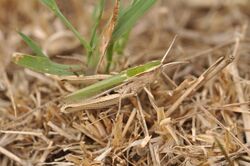Biology:Chorthippus albomarginatus
| Chorthippus albomarginatus | |
|---|---|

| |
| Female showing white wing stripe | |
| Scientific classification | |
| Domain: | Eukaryota |
| Kingdom: | Animalia |
| Phylum: | Arthropoda |
| Class: | Insecta |
| Order: | Orthoptera |
| Suborder: | Caelifera |
| Family: | Acrididae |
| Genus: | Chorthippus |
| Species: | C. albomarginatus
|
| Binomial name | |
| Chorthippus albomarginatus (De Geer, 1773)
| |
File:Chorthippus albomarginatus -- Weißrandiger Grashüpfer.webm Chorthippus albomarginatus, the lesser marsh grasshopper, is a common grasshopper of European grassland both damp-marshy and (despite its name) dry, including salt-marsh and coastal habitats.
Distribution
The range of the lesser marsh grasshopper extends from Finland and southern Scandinavia in the north to Spain and Italy in the south.[1] It was once present only in the southern parts of the UK but has been expanding its range northwards.
Physical appearance
Females grow to approximately 20 millimetres (0.8 in) and are larger than males that grow to approximately 15 mm (0.6 in). The female almost always has a longitudinal white stripe on the wing whereas the male rarely does.
The region behind the head is referred to as the "pronotal side-keels" and the bars are approximately parallel in this species. Although quite similar, it can be distinguished from the meadow grasshopper Chorthippus parallelus, which also has straight pronotal side-keels, by a number of characteristics. These include its ability to fly, white stripe on female's wing, and more pointed snout. It often tends to be less brightly coloured and more straw-brown than Chorthippus parallelus.
Both sexes can be extremely variable in colour from green to brown.
Song and reproduction
The song is very similar to Chorthippus brunneus, though perhaps a little slower, with 2–6 chirps each lasting approximately half a second.[2] There can be an 'alternation song' between competing males. Females lay eggs at the base of grass blades.[3]
Development
More rapid development of C. albomarginatus (maturation at a younger age) was found to be associated with higher DNA damage.[4] The association of increased DNA damage with shorter developmental times suggests that there is a trade-off between genetic integrity and growth rate. Although rapid growth would likely provide a fitness advantage, the increase production of reactive oxygen species associated with rapid development would probably make the individual more subject to oxidative DNA damage with negative consequences later in life.[4]
References
| Wikimedia Commons has media related to Chorthippus albomarginatus. |
- ↑ Heiko Bellmann, Heiko (May 5, 1988). Field Guide to the Grasshoppers and Crickets of Britain and Northern Europe. Collins. ISBN 0-00-219852-5.
- ↑ Michael Chinery (1986). Collins Guide to the Insects of Britain and Western Europe. Collins. ISBN 0-00-219137-7.
- ↑ N. Waloff (1950). "The egg pods of British short-horned grasshoppers (Acrididae)". Proceedings of the Royal Entomological Society of London A 25 (10–12): 115–126. doi:10.1111/j.1365-3032.1950.tb00088.x.
- ↑ 4.0 4.1 Bonisoli-Alquati, A.; Ostermiller, S.; Beasley, A. E.; Welch, S. M.; Møller, A. P.; Mousseau, T. A. (2018). "Faster Development Covaries with Higher DNA Damage in Grasshoppers (Chorthippus albomarginatus) from Chernobyl". Physiological and Biochemical Zoology 91 (2): 776–787. doi:10.1086/696005. PMID 29309248.
Wikidata ☰ Q1755270 entry
 |


